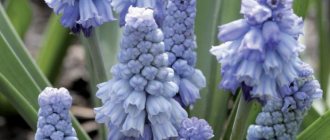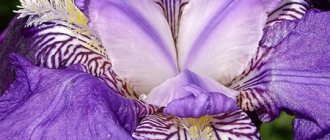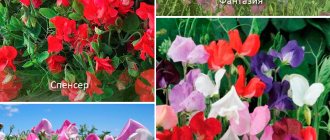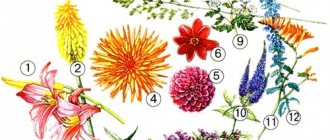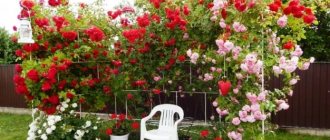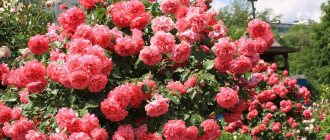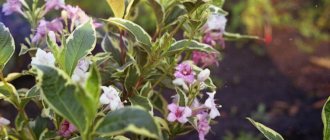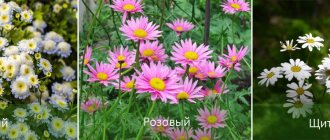For their wonderful and unusual coloring, the Greeks named irises in honor of the goddess of the rainbow. And because of their amazing shape, people sometimes call them “northern orchids.” According to legend, these flowers appeared by the sea, where they sprouted from the tears of a woman who was waiting for her sailor husband during a storm. Like small beacons, bright buds illuminated the path. Today we will talk about irises and caring for them!
general information
Irises are called differently in different regions - irises, cockerels, magpie flowers or braids. They are notable for the bizarre shape of their petals, painted in all sorts of colors of the rainbow. The leaves are long and flat, sword-shaped and with a waxy surface.
Iris flowers are large and fragrant, with six petals: three turned down and three more fused and raised up. They grow solitarily, but occasionally larger inflorescences are found. Irises are quite capricious to care for, but in return the flowerbed will delight you with unprecedented beauty from May to July.
Types of irises
Irises are found all over the world, and the varieties number in the hundreds. Among them there are bulbous and rhizomatous - they differ slightly in the specifics of planting. Some varieties bloom twice - the second time closer to autumn.
Bearded iris
The most common in our country are German or bearded irises, which got their name from the characteristic shape of the flower. Among them there are many interesting multi-colored varieties with smooth or wavy petals - Acoma, Bewilderbest, Baltic Sea and others.

Siberian iris
The flowers of Siberian irises open up to 10 cm, and most often their shades are in the blue-violet range. This is a tall species - up to 80 cm, and it does not have the characteristic iris smell at all.
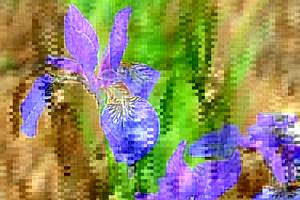
Swamp iris
This is perhaps the only group of irises that prefers moist, marshy soil. Flowers most often come in all shades of yellow, lemon or cream, like those of Umkirch, Golden Queen or Flore Pleno.
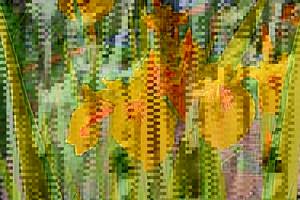
Japanese iris
Japanese irises, also called sword-shaped, are dotted with large blue flowers up to 25 cm. In mid-latitudes, the varieties Nessa-No-Mai, Vasily Alferov and Solveig take root well.
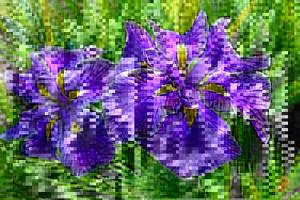
Iris Spuria
Iris Spuria is similar to the bulbous varieties, but its flowers are much larger. It easily tolerates drought and winter frosts, and in season it delights with variegated multi-colored petals of the Transfiguration, Lemon Touch and Stella Irene varieties.

Border varieties of irises
Miniature border irises are extremely hardy and require little care. You can find a place for them in any garden, which is why dwarf varieties are in particular demand.
Beau
The miniature variety has purple standards and dark purple fouls with a lighter edge. The beard of the buds is light blue, densely pubescent. The height of the plant is only about 30 cm, the variety is well suited for borders.
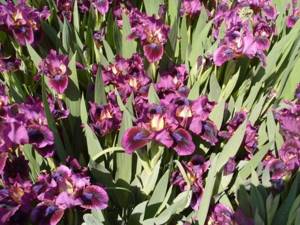
Iris Beau blooms in late spring
Carats
The compact iris, up to 20 cm in height, has golden upper and lower lobes. The standards are slightly brighter than the fouls; the beard of the variety is white and yellow. The flower looks good in illuminated areas of the garden and harmoniously combines with light and dark perennials.
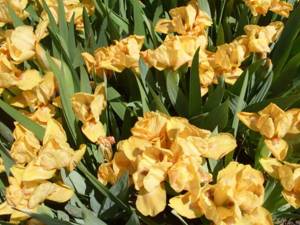
Iris Carats blooms in July
Chanted
A dwarf flower up to 20 cm above the ground has soft pink petals with a bright blue beard in the middle and the same veins under it. Suitable for breeding in northern regions, as it easily tolerates frost and grows quickly and actively.

Chanted iris blooms in May
Demon
Iris with a rich wine-red hue of petals and blue-violet beards reaches 15-20 cm above ground level. Flowering begins at the end of May. Iris grows well in dry areas, has high vitality and does not require special care.
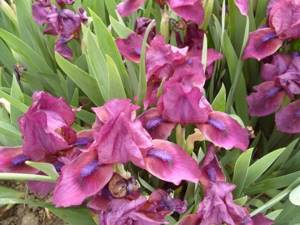
Flowers of the Demon variety reach 7 cm in diameter
Double Lament
The dark purple variety with blue beards blooms in mid-June or early July. Looks good in miniature compositions and as part of borders.
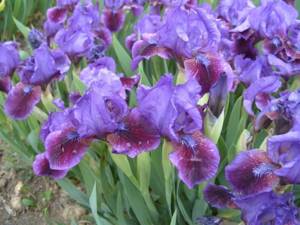
Iris Double Lament rises up to 30 cm above the ground
Caring for irises
The most important thing is to start caring for irises in early spring, and then they will bloom on time and abundantly. As soon as the snow melts, remove the cover from the flowerbed and gradually return it to everyday mode.
Temperature and lighting
Irises love the sun and warmth, so flower beds can be safely planted in open sunny areas. But they do not tolerate drafts and cold winds, so take care of protection in bad weather.
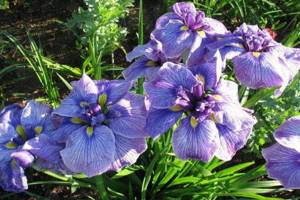
Watering
Irises love water very much, especially during intensive growth and flowering. At the same time, you cannot overwater the root system, otherwise it will rot. We recommend moistening the soil between plants at a rate of up to 20 liters per square.
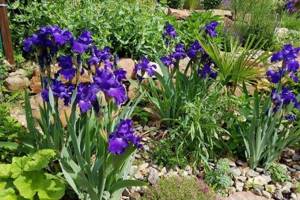
The soil
Before planting, pass the top layer of soil through a large sieve and treat it with antiseptics and combicides. Choose neutral or slightly acidic soil. Be sure to carefully loosen the row spacing every week and a half so that oxygen gets to the roots.
We recommend removing weeds by hand, because normal working tools can damage the overgrown root. Irises do not tolerate close groundwater and need good drainage, with the exception of some marsh and Siberian varieties.
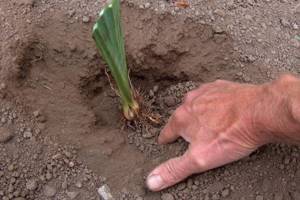
Fertilizers and fertilizing
Iris blooms profusely and brightly, so from early spring it needs regular feeding. First, 10 g of nitrogen per square, when the flowers begin to produce leaves. After two weeks, add 15 g of potassium and phosphorus to the nitrogen, and during flowering, completely abandon nitrogen and increase the remaining dosages to 20 g.
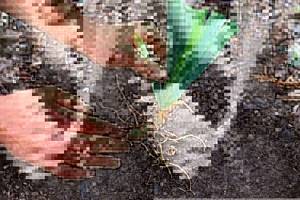
Transplantation and propagation
Irises are planted in the spring from cuttings purchased in the store or prepared in the fall. Disinfect the planting material with potassium permanganate and treat it with a growth stimulator. Make a hole up to 25 cm, and in it - a small mound to carefully spread the rhizome over it.
When planting iris, the root collar should be at soil level, and the distance between flowers should be from 30 to 50 cm, depending on the size of the variety. Rhizomatous ones can be planted in early September, and bulbous ones - from September to October. Fan out the leaves to the north so that the flower shades itself on hot days. Preventative transplantation of iris is not necessary.
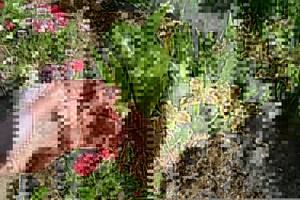
Trimming
When the plant fades, do not forget to remove the flower stalks so that they do not rot and spread disease. If the leaves turn yellow and dry, carefully cut them into a semicircle and treat them with an antiseptic. For the winter, leave 10-15 cm of shoots, cover the exposed roots with soil and mulch with a thick layer of peat up to 10 cm.

Winter storage
Heat-loving varieties of irises will have to be dug up for the winter and stored separately. Dry the rhizomes, put them in a closed cardboard box, cover them with peat or sawdust and leave them to winter on the balcony or in the basement. Moisture-loving varieties need to be pruned, disinfected and replanted in pots.
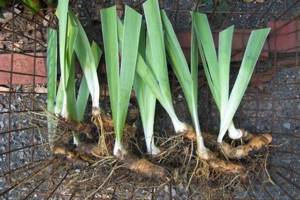
Bearded irises
This group is divided into several subgroups, differing in peduncle height, flower size and flowering time:
- Tall - characterized by large, luxurious flowers and a long (from 0.7 to 1.20 m) peduncle.
- Borders - peduncle from 0.41 to 0.7 m.
- Miniature tall - the sizes are the same as the previous group, but differ in small flowers and a thinner stem.
- Interlude - differ in flowering time, reaching a height of 0.41 to 0.7 m.
- Standard dwarf - the size of the peduncle varies from 0.21 m to 0.4 m.
- Miniature dwarf - bloom very early and have the smallest flowers. The height of the peduncle is up to 0.2 m.
All presented plants have different flowering periods: from very early to late. By choosing the right varieties, you can enjoy their beauty almost all summer.
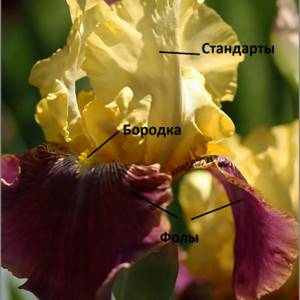
Structure of the bearded iris flower: standards, beard, fouls
The colors of bearded irises can be one-color, two-tone, or two-color. Two-color, depending on the color transition, are divided into: amena (standards are white), variegata (standards are yellow, fouls are deep red), iridescent (colors change gradually), plicata (petals are decorated with strokes, dots, borders), luminata (light-colored veins on a dark background), fancy plicate (veins and various strokes or dots are combined in color).
Breeding bearded iris is not a very difficult task, which is why hundreds of new varieties appear every year. The largest farms for breeding these flowers are located in the USA, Australia and France. In Holland they specialize in bulbous irises.
New products from the world selection 2021:
Tall:
SPICE GIRLS - a flower of delicate yellow-orange shades. The inner lobes of the perianth are strongly corrugated, pale yellow. The lower lobes are brighter, orange-brown in color. The beard is dark orange.
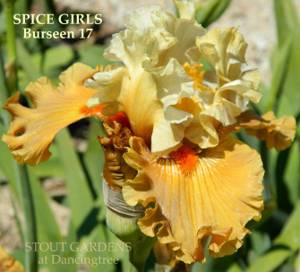
CAMPFIRE TALES - bright orange color. The lower lobes of the perianth are pale brown with a golden border. The beard is light brown, with white markings on the petal around it. The upper lobes are strongly pressed against each other.
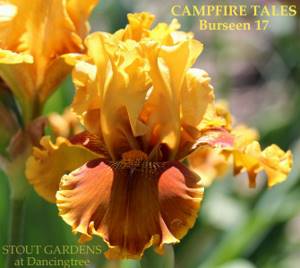
FACE LIFT – with an unusual flower shape, similar to a gypsy skirt – very flared, with wavy edges. Delicate creamy color with yellow veins. The beards are orange.
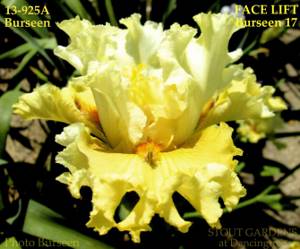
COWPOKE – Standards (upper perianth lobes) bright apricot. The follae (lower parts of the perianth) are velvety, berry-black, with purple veining around a red-orange beard.
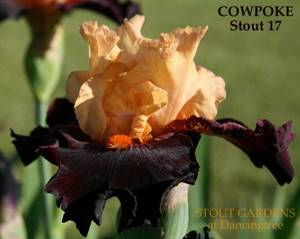
Standard dwarf:
COLD HEARTED – grows up to 30 cm. The standards are soft burgundy, slightly wavy, the fouls are a deep red-burgundy color, with a smooth edge, the beard is creamy.
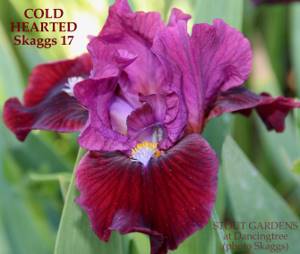
VOLCANIC SPRITE - grows up to 28 cm. Standards are pale purple, white at the edges, dark red-violet at the base; fouls - pale purple, white at the edges, brick red in the middle; the hairs on the beards are white, light yellow; The flower has a light pleasant aroma.
![]()
TOO COOL FOR SCHOOL - all the petals are icy blue-violet, the beard is white, with golden-yellow tips.
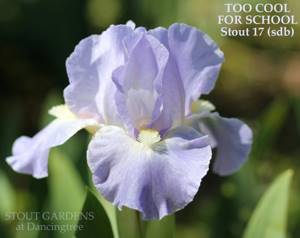
RHOSLYN BERRY – loose, open flower. Standards are crimson-violet, fouls are the same color with a dark red spot in the middle. The beard is purple. Has a light pleasant aroma.
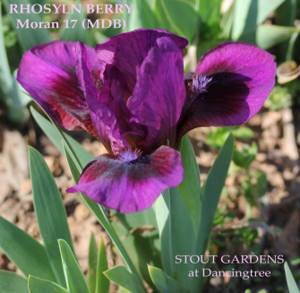
Pest and disease control
Irises are not too painful and most often suffer from root rot or bacteriosis. Tubers accumulate water, and in combination with waterlogged soil, frost or excess organic fertilizers, the result will not be long in coming. Therefore, inspect the flower bed regularly, especially after winter, to immediately remove damaged tubers.
Of the fungal diseases, rhizoctonia and fusarium most often develop, especially in cold, rainy spring. For prevention, do not forget about seasonal spraying with fungicides and be sure to treat the tubers before planting.
Thrips, aphids, iris flies and cutworm butterflies love to eat irises, and large tubers attract wireworms and beetle larvae. Nematodes cause many diseases, complications and developmental delays. Be sure to dig up the soil at the beginning of the season, apply antiseptics and use insecticides.

Use in landscape design
Breeders involved in breeding and improving the breed of all varieties of iris could not ignore the marsh iris. And it’s not surprising: this flower, like no other, can decorate a man-made pond, if one is provided by the landscape designer.
Marsh iris can be used to decorate both flower beds located in the lowlands of the site and the water area of a pond, swamp, or man-made dam. The plant can look especially impressive on an artificial island in the middle of the water surface. A group of boulders or one large stone next to the iris planting is also an excellent option.
Irises – photo
Irises are one of the most unusual flowers in the garden, because they managed to obtain from Mother Nature both a bizarre shape and an outlandish color. Just look at the photo!
